JAPAN
Shichifukujin – The Seven Lucky Gods

The images Hansatsu are often perplexing and seemingly unknowable. It would seem that unless you speak Japanese or have a good friend who does, the notes will have almost no appreciable meaning besides perhaps a denomination, a date and maybe a location. In an attempt to broaden my view on these notes, I was wondering about some of those images of people on Hansatsu. Were they, or the animals on the notes of any signifigance? Well, sometimes at least, the answer is yes, they are significant. And sometimes, in fact quite often enough, the characters on them are one or more of a group of 7 gods.
Collectively, they are known as the Shichifukujin, The Seven Lucky Gods, the Gods of Heavenly Bliss, or other close translations. They are an assemblage of beneficent deities that stem from India, China and Japan. The Seven Gods were first mentioned in texts as far back as the year 1420, and have had all that time to endear themselves to the Japanese. Every New Year, the Seven Gods will sail on a treasure ship named the Takarabune, which sails from Heaven to earth, and for the first three days of the year, will enter the cities where they dispense their goodwill and treasure. The treasure in the boat is not monetary in nature but more endearing, such as:
the Orimono, Bolts of fabric
the Kanebukuro a bag that is endless
The Kagi, sacred keys to the shed of the Gods
The Kozuchi, Daikoku’s magical mallet that spouts coins
The Makimono, Scrolls of the sacred books of wisdom and life
the Kaguregasa, a hat that makes the wearer invisible, which, along with
The Hagoromo, a coat of fairy feathers, giving the wearer the ability to fly
the Kakuremino, a raincoat that makes the wearer invisible, presumably to do good deeds
The Nunobukuro, Hotei’s bag, containing all the needs of man, such as food, drink, clothing, etc.
The Seven Lucky Gods share some similarities with another set of gods in China, known as the Eight Immortals. They too have a magical boat and some even share distinctive physical characteristics and personalities. There are some who are almost identical to their Chinese counterparts, such as the Chinese god Shou, with a large forehead, and the Japanese god with the same type of head, Fukurokuju. This is not surprising given the spread of their influence from India. Even so, the Shichifukujin have had plenty of time to adjust to the Japanese culture and have become favorites throughout the country. Hansatsu was printed and used as currency from approximately 1680 – 1875. Images in this article are largely taken from such Hansatsu.
Benzaiten –
The only female of among the seven, she is the goddess of music, arts, and language. Benzaiten, also known as Benten, originally came from India where she was a river goddess known as Sarasvati, and came to Japan as a multi-armed defender of Buddhism. She is associated with the Wish Granting Jewel, called the Hoju, which is illustrated as a large tear shaped jewel surrounded by flames, or radiance.

Benten is usually portrayed with a stringed instrument called a Biwa, and she is thus revered among musicians. In the earlier days, many musicians would not marry for fear that Benten would become jealous, and no longer bless them with her kindness, and they would lose their talent and skills. https://www.youtube.com/watch?v=bnt4CSZVJy8
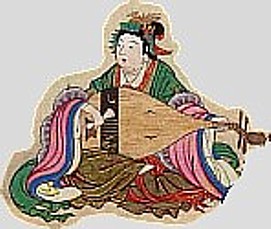

Though benevolent, she has a propensity towards jealousy, personified by her messenger snakes that are often times depicted as coiled around her. Another aspect of her jealously is that couples should never worship Benten together, for if they do, Benten would become jealous and cause the their relationship to end.
Benten is the goddess of the arts, geishas, composers, designers, painters, sword makers and even gamblers. Benten is also an agricultural goddess who is called upon for rain and abundant harvests.
One of the forms that Benzaiten has adopted is that of “Happi Benzaiten”, or ‘Eight-armed Benzaiten”. Happi Benzaiten is looks like a warrior goddess, and in this role is the defender of both the Bhuddist faith and the government. Her hands are often shown holding items that are symbolic of this role, including: A bow, an arrow, a sword, an axe, a spear, a long pestle, the Dharma Wheel, and some rope. While these items are typical, they are often replaced with other objects which are associated with luck and wealth. Such items include the wish granting jewel, known as the Hoju 宝珠 or sometimes 寶珠, and the Sutra Scroll, which aids in the study of Bhuddist scripts, and a key to a storehouse.
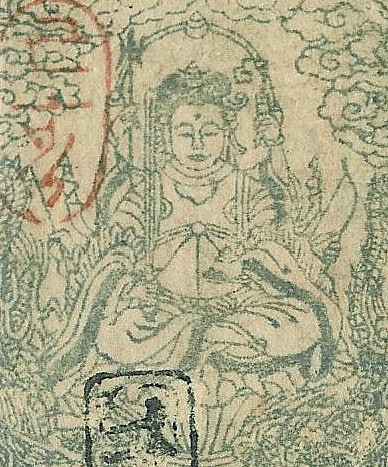
There are other versions of Benzaiten, including this one, with only six arms, which holds a bow, a Key, the Hoju Jewel, a sword, a spear/trident, and what looks to be an axe.
The multi-armed Benzaiten has been traced back in some respects to the Hindu goddess Durgā who is an aspect of Kali, the goddess of death. In India, Kali is mostly depicted as having eight arms. Over time, distance and through culture, Benzaiten would eventually morph into the lovely two armed biwa player seen above, and be predominately a goddess of water and the arts.
Daikoku –
Probably the most depicted of the seven gods on Hansatsu banknotes, Daikoku is a corpulent man standing on two barrel shaped rice bales, and carrying an oversized sack over his shoulder. Daikoku, or Daikokuten, originated from the Buddhist faith in India, where he was known as Mahakala and was a fierce warrior god. He made his way to Japan by the eighth century where, over time, he lost his fierce ways and became a chubby, happy man. Daikoku since adopted a large magic, treasure sack, bales of rice, and a small cap. The oversized sack of treasure has in it three items, in abundance: Wealth, Wisdom and Patience. Daikoku became the god of wealth, happiness, farming, and good fortune. He rapidly grew into a favorite deity throughout Japan.
He is invariably shown standing on two bales of rice holding his magic mallet and treasure sack. His association with rice and agriculture has also made him a favorite deity for cooks and his semblance is found in many kitchens. Tradition also has it that the main support column in a house is often called the Daikokuten pole, meant to support the house with good fortune. Daikoku can also be seen with his helper, a white rat, who once chased away a demon who sought to capture Daikoku.
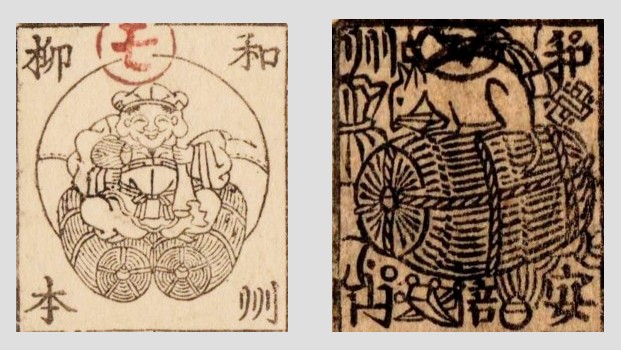
The magical wooden mallet, called the Uchide-no Kuzuchi, is able to grant whatever wish you want when it is struck on the ground, and when shaken, coins will magically appear to fall out of it. The mallet contains a wish granting jewel, the Hoju that is a special symbol of power in Buddhism. The Hoju is said to grant wishes, bring calm, and give understanding of the Dharma, or Buddhist law. The Dharma is also considered to be wealth in Buddhist teachings. The jewel has also been said to contain the sacred ashes of the Buddha himself. The mallet is sometimes seen with three jewels in a flame. The three jewels and flame are, along with rice, powerful fertility symbols. These jewels are often shown on the ends of the rice bales.
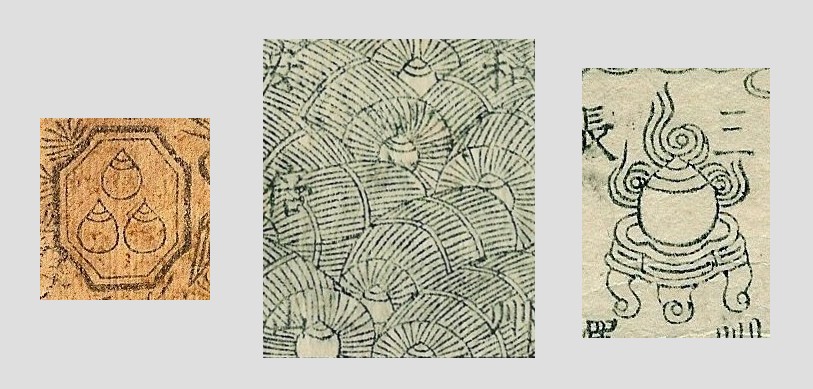
Daikoku is somtimes depicted with three heads, and is then known as the Sanmen Daikoku, which is depicted to show him as the protector of the three Buddhist “Treasures”: Buddha himself, Law and Buddhist disciples. This depiction of him was quite popular during Japan’s Edo Period. Daikoku is a favorite of farmers, businessmen, miners, artisans, craftsmen and iron workers.

Ebisu –
A native Japanese god, who some believe was a real person named Kotoshiro-Nushi-no-Mikoto, Ebisu is the god of candor, wealth, food, fishing, sailors, farming, management and fair dealings. Some believe he was the offspring of Daikoku, as they share many similar attributes. Ebisu loves to fish, and is constantly wandering off to a stream, lake or the sea.
Ebisu is bearded and often shown smiling and dressed in courtly garments with a folded hat of the kind that court officials used to wear. Despite his courtly appearance, he is always seen with a fishing pole and carrying a large fish, either a red snapper or sea bream, both fish which symbolize fortune. He less commonly holds a folding fan rather than a fish or fishing rod.
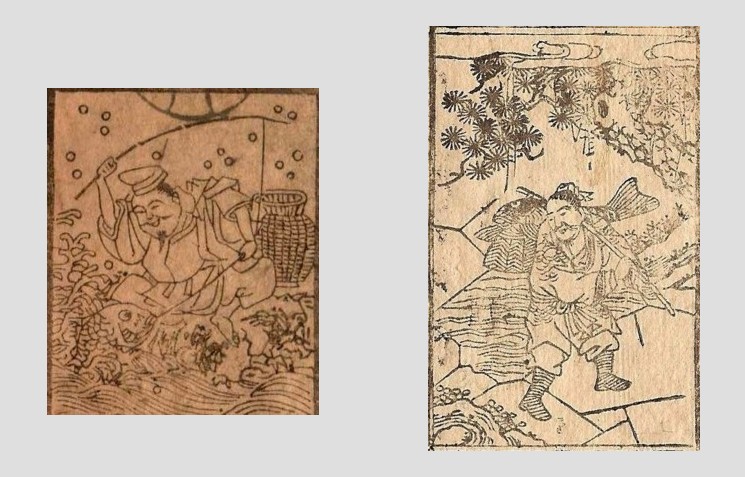
Ebisu is also the only one of the seven lucky gods original to Japan. It is common for Ebisu to be together with the god Daikoku.
Ebisu is also the only god with a day dedicated to him, the 20th of October, known as Ebisu-ko, a day for sales and discounts in shops. Despite sounding like a modern sales scheme, this day started in ancient times by merchants seeking forgiveness for buying cheaply and selling high. He is followed by lawyers, collectors, editors, managers, fishermen, sailors and merchants.
Hotei –
Hotei is also known outside of Japan as the Fat Buddha or Laughing Buddha. He is magnanimous, a protector of children and is revered by attorneys, cooks and politicians, bartenders and fortunetellers.
Originally, from China, Hotei was actually a real person named Kaishi who lived in the 10th century. Kaishi was a Zen priest, whose belly was so large that it always protruded from his robes, giving him his iconic look. An eloquent speaker, he could quote religious texts and was himself a fortuneteller. He is often depicted as carrying a large bag, known as the Nunobukuro, which, no matter how much is taken out, will never empty. From his bag, he gladly dispenses needful items to those in need. “Hotei” actually means “cloth sack.”

Bishamon –
Also known as Bishamonten, his history originates from India, where he was called Vaisravana, and was worshipped as a god of prosperity and happiness. Dressed in armor and carrying a spear, he at first he looks like a bearded warrior but he is the guardian of Buddha and his virtues, and a protector of the other Lucky Gods. In Japan, he has become a defender against evil, a god of both dignity and fortune. He has become a patron of doctors and nurses, soldiers, police officers and priests.
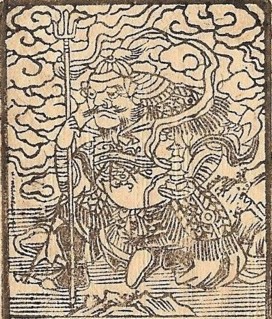
Bishamon carries a small tower in one hand, which represents a stronghold of the Buddhist faith and the treasure tower of wealth. The treasures therein are Faith, Straight-forwardness, Duty and Honor, and symbolically represent the Buddha’s body. Bishamon is both the protector and dispenser of its bounty. He only shares these treasures with those he deems worthy.
Fukurokuju –
A god of happiness, riches and longevity, Fukurokuju is the only one of the Seven Lucky Gods who is said to be able to restore the dead to life, and is considered to be immortal, and does not have to eat. He is quite often depicted with a tortoise, snake or stork and many times with a white stag. These animals symbolize long life.

He is also the oddest looking of the seven. He is always depicted wearing the robes of a Chinese scholar, and is quite short. As if to make up for his shortness, he has a very elongated forehead, which is often seen as more than half of his approximately three-foot height. He also has large eyes with a long white beard. Fukurokuju is the god of wealth, happiness, and longevity, and he loves to play chess. Fukurokuju is followed by athletes, gardeners, jewelers, magicians, watchmakers, and of course, chess players.

Jurojin –
A god of wisdom and longevity, he is depicted as an old, bearded man with a scroll attached to a holy staff, which only a very few worthy persons are allowed to peak at. Some think the scroll contains all the deeds of every person in the world, and holds the knowledge of the human heart. It also contains the life span of all living things. He has some similar attributes to Fukurokuju, such as being accompanied by a deer, but Jurojin’s deer is supposed to be black, which symbolizes extreme longevity. Jurojin also has a long forehead, but not nearly as long as his shorter companion does. They are quite easily told apart due to Jurojin’s nearly six foot height. He also carries a fan with a sermon of the Buddha on written on it.

A heavy drinker who is fond of female company, Jurojin is said to be based on an actual person from the 11th century. He is a favorite of accountants, astronomers, engineers, explorers, inventors, journalists, judges, scientists, secretaries, and teachers.
Sources:
http://www.onmarkproductions.com/html/benzaiten.shtml
The Seven Lucky Gods of Japan by Reiko Chiba
The Heavenly Gods of Bliss by TeitaroSuzuki The Open Court MagazineVolume XXI 1907
Japan’s Seven Jolly Gods by Paul Carus The Open Court Magazine Vol 1901/Vol1
Library of Congress drawing: Shichifukujin
www.Banknoteden.com